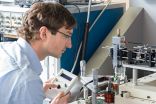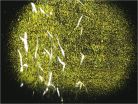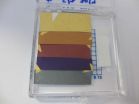(Press-News.org) This news release is available in German.
Electrical engineers at the Technische Universität München (TUM) have demonstrated a new kind of building block for digital integrated circuits. Their experiments show that future computer chips could be based on three-dimensional arrangements of nanometer-scale magnets instead of transistors. As the main enabling technology of the semiconductor industry – CMOS fabrication of silicon chips – approaches fundamental limits, the TUM researchers and collaborators at the University of Notre Dame are exploring "magnetic computing" as an alternative. They report their latest results in the journal Nanotechnology.
In a 3D stack of nanomagnets, the researchers have implemented a so-called majority logic gate, which could serve as a programmable switch in a digital circuit. They explain the underlying principle with a simple illustration: Think of the way ordinary bar magnets behave when you bring them near each other, with opposite poles attracting and like poles repelling each other. Now imagine bringing several bar magnets together and holding all but one in a fixed position. Their magnetic fields can be thought of as being coupled into one, and the "north-south" polarity of the magnet that is free to flip will be determined by the orientation of the majority of fixed magnets.
Gates made from field-coupled nanomagnets work in an analogous way, with the reversal of polarity representing a switch between Boolean logic states, the binary digits 1 and 0. In the 3D majority gate reported by the TUM-Notre Dame team, the state of the device is determined by three input magnets, one of which sits 60 nanometers below the other two, and is read out by a single output magnet.
The Latest in a Line of Advances
This work builds on capabilities the collaborators have developed over several years, ranging from sophisticated simulations of magnetic behavior to innovative fabrication and measuring techniques. It also represents not an end point but a milestone in a series of advances.
For example, they reported the world's first "domain wall gate" at last year's International Electron Devices Meeting. The scientists use focused ion-beam irradation to change the magnetic properties of sharply defined spots on the device. So-called domain walls generated there are able to flow through magnetic wires under the control of surrounding nanomagnets. This 2D device, TUM doctoral candidate Stephan Breitkreutz explains, "enables signal routing, buffering, and synchronization in magnetic circuits, similar to latches in electrical integrated circuits."
A Fork in the Industry Roadmap
All players in the semiconductor business benefit from one industry-wide cooperative effort: developing long-range "roadmaps" that chart potential pathways to common technological goals. In the most recent issue of the International Technology Roadmap for Semiconductors, nanomagnetic logic is given serious consideration among a diverse zoo of "emerging research devices." Magnetic circuits are non-volatile, meaning they don't need power to remember what state they are in. Extremely low energy consumption is one of their most promising characteristics. They also can operate at room temperature and resist radiation.
The potential to pack more gates onto a chip is especially important. Nanomagnetic logic can allow very dense packing, for several reasons. The most basic building blocks, the individual nanomagnets, are comparable in size to individual transistors. Furthermore, where transistors require contacts and wiring, nanomagnets operate purely with coupling fields. Also, in building CMOS and nanomagnetic devices that have the same function – for example, a so-called full-adder – it can take fewer magnets than transistors to get the job done.
Finally, the potential to break out of the 2D design space with stacks of 3D devices makes nanomagnetic logic competitive. TUM doctoral candidate Irina Eichwald, lead author of the Nanotechnology paper, explains: "The 3D majority gate demonstrates that magnetic computing can be exploited in all three dimensions, in order to realize monolithic, sequentially stacked magnetic circuits promising better scalability and improved packing density."
"It is a big challenge to compete with silicon CMOS circuits," adds Dr. Markus Becherer, leader of the TUM research group within the Institute for Technical Electronics. "However, there might be applications where the non-volatile, ultralow-power operation and high integration density offered by 3D nanomagnetic circuits give them an edge."
INFORMATION:
This research was supported by the German Research Foundation (DFG).
Publications
Majority logic gate for 3D magnetic computing, Irina Eichwald, Stephan Breitkreutz, Grazvydas Ziemys, György Csaba, Wolfgang Porod, and Markus Becherer. Nanotechnology, 25 (2014) 335202, doi:10.1088/0957-4484/25/33/335202.
Domain Wall Gate for Magnetic Logic and Memory Applications with Perpendicular Anisotropy, S. Breitkreutz, G. Ziemys, I. Eichwald, J. Kiermaier, G. Csaba, W. Porod, D. Schmitt-Landsiedl, and M. Becherer. IEEE International Electron Devices Meeting (IEDM 2013), pp. 22.4.1-22.4-4, doi:10.1109/IEDM.2013.6724684.
The 2014 Magnetism Roadmap, Robert L. Stamps, Stephan Breitkreutz, et al. J. Phys. D: Appl. Phys. 47 (2014) 333001. doi:10.1088/0022-3727/47/33/333001.
Contact
Irina Eichwald
Institute for Technical Electronics
Technische Universität München
+49 89 289 22923
irina.eichwald@tum.de
Stephan Breitkreutz
Institute for Technical Electronics
Technische Universität München
+49 89 289 22348
stephan.breitkreutz@tum.de
Markus Becherer
Institute for Technical Electronics
Technische Universität München
+49 89 289 22915
markus.becherer@tum.de
Further Information
http://www.lte.ei.tum.de
Technische Universität München (TUM) is one of Europe's leading research universities, with around 500 professors, 10,000 academic and non-academic staff, and 36,000 students. Its focus areas are the engineering sciences, natural sciences, life sciences and medicine, reinforced by schools of management and education. TUM acts as an entrepreneurial university that promotes talents and creates value for society. In that it profits from having strong partners in science and industry. It is represented worldwide with a campus in Singapore as well as offices in Beijing, Brussels, Cairo, Mumbai, and São Paulo. Nobel Prize winners and inventors such as Rudolf Diesel and Carl von Linde have done research at TUM. In 2006 and 2012 it won recognition as a German "Excellence University." In international rankings, it regularly places among the best universities in Germany.
http://www.tum.de
A new dimension for integrated circuits: 3-D nanomagnetic logic
Field-coupled magnets could replace transistors in some computer chips
2014-09-30
ELSE PRESS RELEASES FROM THIS DATE:
Medicaid and Uninsured patients obtain new patient appointments most easily at FQHCs
2014-09-30
PHILADELPHIA – Federally Qualified Health Centers (FQHCs) granted new patient appointments to Medicaid beneficiaries and uninsured patients at higher rates than other primary care practices (non-FQHCs), in addition to charging less for visits, according to results of a new 10-state University of Pennsylvania study published this month in Medical Care.
Using data from a previous "secret shopper" study conducted in 2012 and 2013, the investigators found that FQHCs — community health clinics that receive federal funding to provide primary care access to underserved populations ...
UCI study uncovers important process for immune system development
2014-09-30
Irvine, Calif., Sept. 30, 2014 — Research by UC Irvine immunologists reveals new information about how our immune system functions, shedding light on a vital process that determines how the body's ability to fight infection develops.
In the online version of Nature Immunology, neurology professor Dr. Michael Demetriou, postdoctoral scholar Raymond Zhou and other Institute for Immunology colleagues describe a critical mechanism underlying how T cells are created, selected and released into the bloodstream.
A T cell is a type of blood cell called a lymphocyte that protects ...
Expect 6,000 more Australian deaths if pollution rises to 'safe' threshold
2014-09-30
The National Environment Protection Measures (NEPM) has set maximum daily limits, or 'standards', for six key outdoor pollutants, which QUT's Associate Professor Adrian Barnett says many authorities wrongly assume to be 'safe' thresholds for health.
To test that assumption, Professor Barnett calculated what the health effects would be if the current average levels of five of those pollutants across Melbourne, Sydney and Brisbane were to rise to just below the NEPM 'safe' standards.
"I've found that increasing pollution levels to just below the NEPM standards would cause ...
How to predict who will suffer the most from stress
2014-09-30
Montreal, September 30, 2014 — More than 23 per cent of Canadians report being stressed or very stressed on most days. While chronic stress increases the risk of poor mental and physical health, not everyone is affected the same way. Some cope well, but for others — especially those most likely to sweat the small stuff — chronic stress can be harmful.
Thankfully, new research from Concordia University has found a way to identify those most susceptible to stress. That's a huge help for healthcare professionals working to stop stress before it gets out of control.
The ...
Antioxidant found in grapes uncorks new targets for acne treatment
2014-09-30
Got grapes? UCLA researchers have demonstrated how resveratrol, an antioxidant derived from grapes and found in wine, works to inhibit growth of the bacteria that causes acne.
The team also found that combining resveratrol with a common acne medication, benzoyl peroxide, may enhance the drug's ability to kill the bacteria and could translate into new treatments.
Published in the current online edition of the journal Dermatology and Therapy, the early lab findings demonstrated that resveratrol and benzoyl peroxide attack the acne bacteria, called Propionibacterium acnes, ...
New hypothyroidism treatment guidelines from American Thyroid Association
2014-09-30
New Rochelle, NY, September 30, 2014—Levothyroxine (L-T4), long the standard of care for treating hypothyroidism, is effective in most patients, but some individuals do not regain optimal health on L-T4 monotherapy. New knowledge about thyroid physiology may help to explain these differences. An expert task force of the American Thyroid Association on thyroid hormone replacement reviewed the latest studies on L-T4 therapy and on alternative treatments to determine whether a change to the current standard of care is appropriate, and they present their recommendations in ...
High-speed drug screen
2014-09-30
CAMBRIDGE, MA -- MIT engineers have devised a way to rapidly test hundreds of different drug-delivery vehicles in living animals, making it easier to discover promising new ways to deliver a class of drugs called biologics, which includes antibodies, peptides, RNA, and DNA, to human patients.
In a study appearing in the journal Integrative Biology, the researchers used this technology to identify materials that can efficiently deliver RNA to zebrafish and also to rodents. This type of high-speed screen could help overcome one of the major bottlenecks in developing disease ...
US military making progress reducing stigma tied to seeking help for mental illness
2014-09-30
The U.S. Department of Defense has made progress in reducing the stigma associated with seeking help for mental illnesses such as depression and post-traumatic stress disorder, but more improvement is still needed, according to a new RAND Corporation study.
Despite efforts of both the Defense Department and the Veterans Health Administration to enhance mental health services, many service members still do not seek needed care for mental health problems. Defense officials have made a concerted effort to promote treatment as a way to reduce stigma, according to the study. ...
Laser-guided sea monkeys show how zooplankton migrations may affect global ocean currents
2014-09-30
WASHINGTON, D.C., September 30, 2014--Sea monkeys have captured the popular attention of both children and aquarium hobbyists because of their easily observable life cycle -- sold as dehydrated eggs, these tiny brine shrimp readily hatch, develop and mate given little more than a tank of salt water.
Physicists, though, are interested in a shorter-term pattern: Like other zooplankton, brine shrimp vertically migrate in large groups in response to changing light conditions, coming closer to the surface at night and retreating deeper during the day.
Two researchers at ...
Taking thin films to the extreme
2014-09-30
WASHINGTON D.C., September 30, 2014 – Applying a well-known optical phenomenon called thin-film interference, a group of researchers at Harvard University has demonstrated the ability to "paint" ultra-thin coatings onto a rough surface -- work that holds promise for making future, flexible electronic devices, creating advanced solar cells and detailing the sides of next-gen rocket ships and spacecraft with extremely lightweight decorative logos.
When light passes through oil in water, it becomes iridescent, revealing a myriad of colors that glisten and shift along with ...
LAST 30 PRESS RELEASES:
Heart-brain connection: international study reveals the role of the vagus nerve in keeping the heart young
Researchers identify Rb1 as a predictive biomarker for a new therapeutic strategy in some breast cancers
Survey reveals ethical gaps slowing AI adoption in pediatric surgery
Stimulant ADHD medications work differently than thought
AI overestimates how smart people are, according to HSE economists
HSE researchers create genome-wide map of quadruplexes
Scientists boost cell "powerhouses" to burn more calories
Automatic label checking: The missing step in making reliable medical AI
Low daily alcohol intake linked to 50% heightened mouth cancer risk in India
American Meteorological Society announces Rick Spinrad as 2026 President-Elect
Biomass-based carbon capture spotlighted in newly released global climate webinar recording
Illuminating invisible nano pollutants: advanced bioimaging tracks the full journey of emerging nanoscale contaminants in living systems
How does age affect recovery from spinal cord injury?
Novel AI tool offers prognosis for patients with head and neck cancer
Fathers’ microplastic exposure tied to their children’s metabolic problems
Research validates laboratory model for studying high-grade serous ovarian cancer
SIR 2026 delivers transformative breakthroughs in minimally invasive medicine to improve patient care
Stem Cell Reports most downloaded papers of 2025 highlight the breadth and impact of stem cell research
Oxford-led study estimates NHS spends around 3% of its primary and secondary care budget on the health impacts of heat and cold in England
A researcher’s long quest leads to a smart composite breakthrough
Urban wild bees act as “microbial sensors” of city health.
New study finds where you live affects recovery after a hip fracture
Forecasting the impact of fully automated vehicle adoption on US road traffic injuries
Alcohol-related hospitalizations from 2016 to 2022
Semaglutide and hospitalizations in patients with obesity and established cardiovascular disease
Researchers ‘listen in’ to embryo-mother interactions during implantation using a culture system replicating the womb lining
How changing your diet could help save the world
How to make AI truly scalable and reliable for real-time traffic assignment?
Beyond fragmented markets: A new framework for efficient and stable ride-pooling
Can shape priors make road perception more reliable for autonomous driving?
[Press-News.org] A new dimension for integrated circuits: 3-D nanomagnetic logicField-coupled magnets could replace transistors in some computer chips






